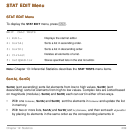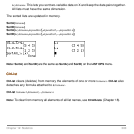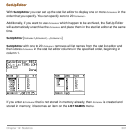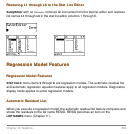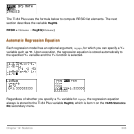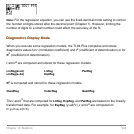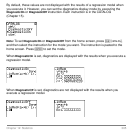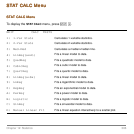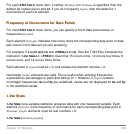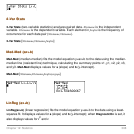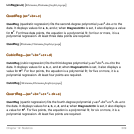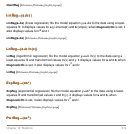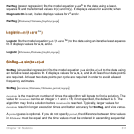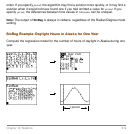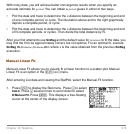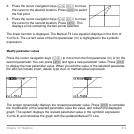
Chapter 12: Statistics 307
For each STAT CALC menu item, if neither Xlistname nor Ylistname is specified, then the
default list names are
L1 and L2. If you do not specify freqlist, then the default is 1
occurrence of each list element.
Frequency of Occurrence for Data Points
Frequency of Occurrence for Data PointsFrequency of Occurrence for Data Points
Frequency of Occurrence for Data Points
For most
STAT CALC menu items, you can specify a list of data occurrences, or
frequencies (
freqlist).
Each element in
freqlist indicates how many times the corresponding data point or data
pair occurs in the data set you are analyzing.
For example, if
L1={15,12,9,14} and ÙFREQ={1,4,1,3}, then the TI-84 Plus interprets the
instruction
1-Var Stats L1, ÙFREQ to mean that 15 occurs once, 12 occurs four times, 9
occurs once, and 14 occurs three times.
Each element in
freqlist must be ‚ 0, and at least one element must be > 0.
Noninteger
freqlist elements are valid. This is useful when entering frequencies
expressed as percentages or parts that add up to 1. However, if
freqlist contains
noninteger frequencies,
Sx and Sy are undefined; values are not displayed for Sx and Sy
in the statistical results.
1-Var Stats
1-Var Stats1-Var Stats
1-Var Stats
1-Var Stats (one-variable statistics) analyzes data with one measured variable. Each
element in
freqlist is the frequency of occurrence for each corresponding data point in
Xlistname. freqlist elements must be real numbers > 0.
1-Var Stats [Xlistname,freqlist]



